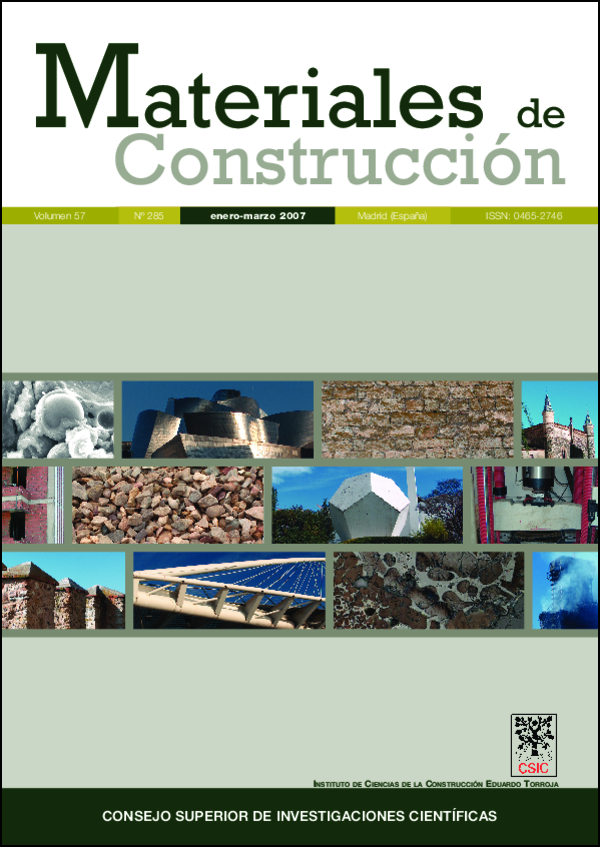Effect of kaolin treatment temperature on mortar chloride permeability
DOI:
https://doi.org/10.3989/mc.2007.v57.i285.39Keywords:
metakaolin, mortars, durability, capillary absorption, chloride permeabilityAbstract
The present paper discusses the results of chloride resistance tests conducted on ordinary Portland cement (OPC) mortars containing a Colombian kaolin pre-treated at temperatures of from 600 to 800 ºC. The resulting metakaolin (MK) was added to OPC mortar mixes in proportions of 10 and 20% by cement weight. The mortars were compared for physical and chemical properties, including capillary absorption, chloride permeability and pore microstructure as assessed by mercury porosimetry. The best performance was recorded for the samples containing 20% of the material treated at 800 ºC.
Downloads
References
(1) Keck, R.: “Improving concrete durability with cementitious materials”, Concrete International, vol. 23, 9 (2001), pp. 47-51.
(2) Mehta, P. K.: “Pozzolanic and Cementituous by-product”, 3rd Int. Conf. on Fly Ash, Silica Fume, Slag and Natural Puzzolans in Concrete (Trondheim), SP 114-1, 1-43 (1989).
(3) Menéndez, G; Bonavetti, V. L.; Irassar, E. F.: “Ternary blended cement concrete. Part I: Early age properties and mechanical strength”, Mater. Construcc., vol. 56, 284 (2006), pp. 55-67.
(4) Khatib, J. M. y Wild, S.: “Pore Size Distribution of Metakaolin Paste”, Cement and Concrete Research, vol. 26, 10 (1996), pp. 1545-1553. doi:10.1016/0008-8846(96)00147-0
(5) Boddy, R.; Hooton, D. y Gruber, K. A.: “Long-Term Testing of the Chloride-penetration Resistance of Concrete Containing High-Reactivity Metakaolin”, Cement and Concrete Research, vol. 31 (2001), pp. 759-765. doi:10.1016/S0008-8846(01)00492-6
(6) Gruber, K. A.: “Increasing Concrete Durability with High-Reactivity Metakaolin”, Cement and Concrete Composites, vol. 23 (2001), pp. 479-484. doi:10.1016/S0958-9465(00)00097-4
(7) Gutiérrez, R. M. de; Delvasto, S. y Talero, R.: “Una nueva puzolana para materiales cementicios de elevadas prestaciones”, Materiales de Construcción, vol. 50, 260 (2000), pp. 5-12.
(8) Frías, M. y Sánchez de Rojas, M. I.: “Influencia del metacaolín en la estructura porosa de matrices a base de MC/Cemento”, Mater. Construcc., vol. 50, 259 (2000), pp. 57-67.
(9) Shvarzman, A. et al: “The effect of dehydroxilation/amorphization degree on pozzolanic activity of kaolinite”, Cement and Concrete Research, vol. 33 (2003), pp. 405-416. doi:10.1016/S0008-8846(02)00975-4
(10) Rahier, H.; Wullaert, B.; Van Mele, B.: “Influence of the degree of dehydroxilation of Kaolinite on the properties of aluminosilicate glasses”, J. Thermal Anal. Calorim., vol. 62 (2000), pp. 417-427. doi:10.1023/A:1010138130395
(11) Kakali, G. et al., “Thermal treatment of kaolin: the effect of mineralogy on the pozzolanic activity”, Applied Clay Science, vol. 20 (2001), pp. 73-80. doi:10.1016/S0169-1317(01)00040-0
(12) Ambroise, J.; Martin-Calle, S. y Pera, J.: “Pozzolanic Behavior of Thermally Activated Kaolin”, Fly Ash, Silica Fume, Slag and Natural Pozzolans in Concrete (1992), pp. 731-747.
(13) Mejía de Gutiérrez, R.; Torres, J.; Guerrero, C.: “Análisis del Proceso Térmico de producción de una puzolana”, Mater. Construcc., vol. 54, 74 (2004), pp. 65-72.
(14) Fagerlund, G.: “On the Capillarity of Concrete”, Nordic Concrete Research, nº1 Paper n°6 (1982), 20 pp.
(15) EMPA - SIA 162/1, Test No. 5 – Water Conductivity, Suiza, 1989.
(16) Khatib, J. y Clay, R.: “Absorption Characteristics of Metakaolin Concrete”, Cement and Concrete Research, vol. 34 (2004), pp. 19-29. doi:10.1016/S0008-8846(03)00188-1
(17) Frías, M. y Cabrera, J.: “Pore Size Distribution and Degree of Hydration of Metakaolin-Cement Pastes”, Cement and Concrete Research, vol. 30 (2000), pp. 561-569. doi:10.1016/S0008-8846(00)00203-9
(18) Batis, G.; Pantazopoulou, P.; Tsivilis, S. y Badogiannis, E.: “The effect of metakaolin on the corrosion behavior of cement mortars”, Cement and Concrete Composites, vol. 27 (2005), pp. 125-130. doi:10.1016/j.cemconcomp.2004.02.041
(19) Poon, C. S.; Kou, C. y Lam, L.: “Compressive Strength, chloride diffusivity an pore structure of high performance metakaolin and silica fume concrete”, Construction and Building Materials, vol. 20, (2006), pp. 858-865. doi:10.1016/j.conbuildmat.2005.07.001
(20) Mejía de Gutiérrez, R. M. de, Delvasto, S.; Gutiérrez, C. y Talero, R.: “Chloride Diffusion measured by a modified permeability test in normal and blended cements”, Advanced in Cement Research, vol. 15, 3 (2003), pp. 113-118. doi:10.1680/adcr.15.3.113.36625
(21) Asbridge, H.; Chadbourn, G. A. y Page, C. L.: “Effects of Metakaolin and the Interfacial Zone on the Diffusion on chloride ions through Cement Mortars”, Cement and Concrete Research, vol. 31 (2001), pp. 1567-1572. doi:10.1016/S0008-8846(01)00598-1
Downloads
Published
How to Cite
Issue
Section
License
Copyright (c) 2007 Consejo Superior de Investigaciones Científicas (CSIC)

This work is licensed under a Creative Commons Attribution 4.0 International License.
© CSIC. Manuscripts published in both the print and online versions of this journal are the property of the Consejo Superior de Investigaciones Científicas, and quoting this source is a requirement for any partial or full reproduction.
All contents of this electronic edition, except where otherwise noted, are distributed under a Creative Commons Attribution 4.0 International (CC BY 4.0) licence. You may read the basic information and the legal text of the licence. The indication of the CC BY 4.0 licence must be expressly stated in this way when necessary.
Self-archiving in repositories, personal webpages or similar, of any version other than the final version of the work produced by the publisher, is not allowed.
















